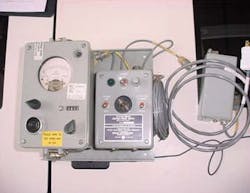Navy gearing up to replace shipboard radiation detection equipment that measures gamma rays
WEST BETHESDA, Md., 28 May 2015. U.S. Navy shipboard electronics experts are planning an industry competition to replace the AN/PDR-65 gamma radiation detection system.
Officials of the Naval Surface Warfare Center Carderock Division in West Potomac, Md., notified industry this week of an upcoming solicitation to provide a high-level conceptual design, computerized drawings, and a physical model of a potential replacement for the Navy AN/PDR-65 radioactivity, detection, indication, and computation (RADIAC) system.
AN/PDR-65 is designed to detect and measure gamma radiation emitted by high-altitude nuclear explosions. Gamma rays are high-energy electromagnetic ionizing radiation that can cause serious or lethal radiation sickness if not detected and shielded against quickly.
Gamma radiation can penetrate the human body easily, and can cause whole-body acute radiation syndrome even before radiation effects are evident on skin.
Related: DARPA asks industry to develop pocket-sized radiation detectors to foil nuclear terrorism
The AN/PDR-65 RADIAC system has two primary elements: the detector unit and RADIAC meter. The detector unit is located at the top of the ship's mast to detect an enveloping radiation cloud and nuclear fallout.
The RADIAC meter is installed on the ship's bridge, and displays gamma ray dose rate and accumulated dose. The primary meter displays the dose rate. Each time the system detects a dose of 1 rad it sounds a loud beep.
Navy officials say they plan to issue a request for proposals on 10 June 2015. Email questions or concerns to the Navy's Ashley Fortson at [email protected].
More information is online at https://www.fbo.gov/spg/DON/NAVSEA/N00167/N65540-15-T-5239/listing.html.

